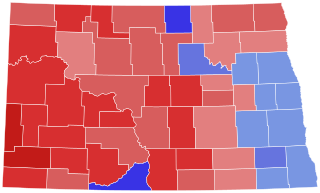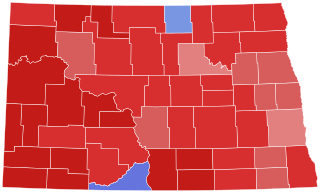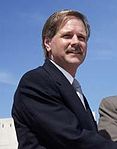
John Henry Hoeven III is an American banker and politician serving as the senior U.S. senator from North Dakota, a seat he has held since 2011. A member of the Republican Party, Hoeven served as the 31st governor of North Dakota from 2000 to 2010.
Joe Satrom is an American businessman and environmental lobbyist from the U.S. state of North Dakota. He won the 2004 Democratic-NPL nomination for governor, but was defeated by the Republican incumbent, John Hoeven.

The North Dakota Republican Party is the North Dakota affiliate of the United States Republican Party.

The 2006 United States Senate election in North Dakota was held November 7, 2006. Incumbent Democratic-NPL U.S. Senator Kent Conrad won re-election to a fourth term. As of 2024, this is the last time where either party won every county for the Class 1 Senate seat in North Dakota.

John Stewart Dalrymple III is an American politician and businessman who served as the 32nd governor of North Dakota from 2010 to 2016. A member of the Republican Party, he previously served as the 36th lieutenant governor of North Dakota from 2000 to 2010 under Governor John Hoeven.

The 2012 United States Senate election in North Dakota took place on November 6, 2012, concurrently with the 2012 U.S. presidential election, other United States Senate elections, United States House of Representatives elections, and various state and local elections. Incumbent Democratic-NPL Senator Kent Conrad decided to retire instead of running for reelection to a fifth term.

The 2008 election for North Dakota's at-large congressional district took place on November 4, 2008. The incumbent, Democratic-NPL Congressman Earl Pomeroy, was re-elected to his ninth term. Republican Duane Sand formally announced that he was running on March 20, 2008. He previously challenged Pomeroy in 2004.

The 2008 North Dakota gubernatorial election took place on 4 November 2008 for the post of Governor of North Dakota. Incumbent Republican governor John Hoeven was easily reelected again, defeating Democratic-NPL challenger Tim Mathern. The primaries took place on June 10, 2008. John Hoeven outperformed John McCain, the Republican presidential nominee, by about 21%. McCain defeated Democratic nominee Barack Obama 53%–45% in the concurrent presidential election.

The 2010 United States Senate election in North Dakota took place on November 2, 2010, alongside other elections to the United States Senate in other states as well as elections to the United States House of Representatives and various state and local elections. Incumbent Democratic Senator Byron Dorgan announced in January 2010 that he would not seek reelection, leading to the first open seat election since 1992. Governor John Hoeven won the seat in a landslide, taking 76.1% of the vote, sweeping every county in the state, and becoming North Dakota's first Republican senator since 1987. Hoeven's 54 point margin of victory was a dramatic and historic shift from the previous election for this seat, when Dorgan won reelection in a 36-point landslide and himself swept every county in the state.

A general election was held in the U.S. state of North Dakota on Tuesday, November 2, 2010, with primary elections being held on June 8, 2010.

The 2012 United States House of Representatives election in North Dakota was held on Tuesday, November 6, 2012, to elect the U.S. representative from the state's at-large congressional district. The election coincided with the elections of other federal and state offices, including a quadrennial presidential election and an election to the U.S. Senate. A primary election was held on June 12, 2012; a candidate must receive at least 300 votes to appear on the general election ballot in November.

The 2012 North Dakota gubernatorial election was held on November 6, 2012, to elect a Governor and Lieutenant Governor of North Dakota, concurrently with the 2012 U.S. presidential election, as well as elections to the United States Senate, elections to the United States House of Representatives and various state and local elections. Incumbent Governor Jack Dalrymple succeeded to the office when then-Governor John Hoeven resigned to take a seat in the U.S. Senate in 2010. Dalrymple, a member of the Republican Party, won election to a full term. Ryan Taylor was the Democratic nominee. Dalrymple prevailed with 63% of the vote; he declined to seek re-election in 2016.

The 2016 North Dakota gubernatorial election was held on November 8, 2016, to elect the Governor and Lieutenant Governor of North Dakota, concurrently with the 2016 U.S. presidential election, as well as elections to the United States Senate, elections to the United States House of Representatives and various state and local elections. This would have been the first time North Dakotans selected a governor under new voter ID requirements, in which a student ID was insufficient identification to vote, but a court ruling in August 2016 struck the down the provision; the election was held under the 2013 rules.

North Dakota held two statewide elections in 2016: a primary election on Tuesday, June 14, and a general election on Tuesday, November 8. In addition, each township elected officers on Tuesday, March 15, and each school district selected a date between April 1 and June 30 to hold their elections. This would have been the first election since the state legislature revoked the ability to use a student or military ID to satisfy state ID voting requirements, but a court ruling in August struck the down the provision, and the election was held under the 2013 rules.

The 2018 United States Senate election in North Dakota took place on November 6, 2018, to elect a member of the United States Senate to represent the State of North Dakota, concurrently with other elections to the U.S. Senate, as well as other federal, state and local elections in North Dakota.

The 2020 North Dakota gubernatorial election was held on November 3, 2020, to elect the governor and lieutenant governor of North Dakota, concurrently with other federal and statewide elections, including the U.S. presidential election. Incumbent Republican governor Doug Burgum and lieutenant governor Brent Sanford were both re-elected to a second term.

The 2018 United States House of Representatives election in North Dakota was held on November 6, 2018, to elect the U.S. representative for North Dakota's at-large congressional district. The election coincided with the U.S. Senate election, as well as other statewide, legislative, and local elections.

The 2022 United States Senate election in North Dakota was held on November 8, 2022, to elect a member of the United States Senate to represent the state of North Dakota. Incumbent Republican John Hoeven was first elected in 2010 with 76% of the vote to succeed retiring Democratic–NPL incumbent Byron Dorgan, and won re-election in 2016 with 78.5% of the vote. He ran for a re-election to a third term in office against Democratic-NPL nominee Katrina Christiansen. He also faced State Representative Rick Becker, who initially ran as a Republican in the primary, but suspended his campaign in August 2022 and instead ran as an Independent.

The 2022 United States House of Representatives election in North Dakota was held on November 8, 2022, to elect the U.S. representative from North Dakota's at-large congressional district. The election coincided with other elections to the House of Representatives, elections to the United States Senate and various state and local elections. Incumbent Republican Kelly Armstrong was re-elected with 69.0% of the vote in 2020. His only opponent in the general election was Independent Cara Mund after Democratic nominee Mark Haugen withdrew.

The 2024 North Dakota gubernatorial election was held on November 5, 2024, to elect the governor of North Dakota. Incumbent Republican governor Doug Burgum decided to not seek re-election to a third term. He would ultimately decide to run for president. The Democratic-NPL has not won a governor's race in North Dakota since 1988.





















